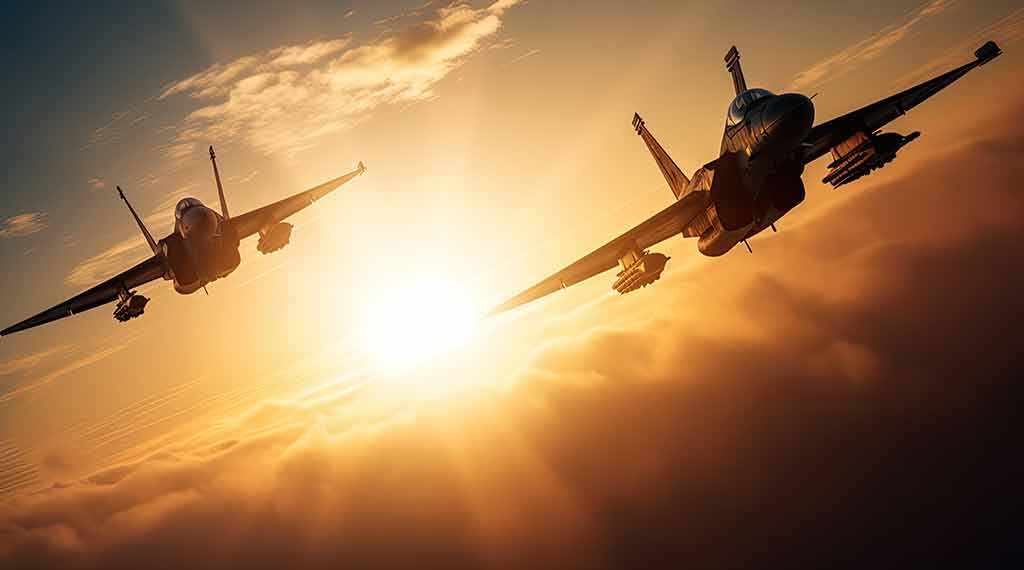
The U.S. Air Force’s multi-tiered Next-Generation Air Dominance program (NGAD) will prioritize concepts including “special warfare” and “spectral dominance,” according to the service’s 2023 Fiscal Year budget request.
NGAD Is Coming
While the cutting-edge F-35 Joint Strike Fighter platform is expected to rule the skies well into the 2070s, the U.S. military is already looking ahead in order to maintain air superiority over its foes.
Now that America’s top adversaries China and Russia are modernizing their own respective next-generation fleets, the NGAD program is paramount.
This upcoming “family of systems” is meant to succeed Lockheed Martin’s F-22 Raptor fighter.
A Brief History of America’s Next-Generation Aircraft Program
Initiated back in 2014, the Air Force’s NGAD program aimed to produce a capable sixth-generation airframe by the 2030s.
The service launched its Aerospace Innovation Initiative within a few years, striving to develop prototypes for future aircraft by incorporating the Defense Advanced Research Project Agency’s (DARPA) Air Dominance study.
NGAD aims to develop a few technological areas, including propulsion, stealth, and advanced weapons.
While limited details surrounding the project were publicized in its earlier stages, the Air Force has recently released some intel.
Last month, the service revealed it plans to possess a fleet of roughly 1,000 unmanned aerial vehicles (UAVs) and 200 NGAD stealth combat fighter jets. The highly autonomous drones, known as collaborative combat aircraft (CCA), will work alongside the sixth-generation aircraft and F-35s.
The Role of Drones in the NGAD Program
Air Force Secretary Frank Kendall described the UAVs as “remotely controlled versions” of electronic warfare or targeting pods currently positioned under the wings of existing fighters.
Although the cost of a single next-generation airframe could cost upwards of hundreds of millions of dollars, the Secretary has defended the price tag because of the comparably low cost of the CCAs.
Secretary Kendall told the House Appropriations defense panel in March that each UAV would cost between one-half and one-quarter as much as an F-35 fighter. Even if America’s aerial capabilities are greater than China’s, the People’s Liberation Army Air Force (PLAAF) is larger. Therefore, Secretary Kendall plans to “create mass” with an abundance of cheaper CCAs.
The Air Force Secretary detailed that “The expectation is that these (unmanned) aircraft can be designed to be less survivable and less capable, but still bring an awful lot to the fight in a mixture that the enemy has a very hard time sorting out and dealing with,” adding that “You can even intentionally sacrifice some of them to draw fire, if you will, to make the enemy expose himself.”
What About the Remaining F-22s?
Since its introduction as the world’s premiere fifth-generation fighter, the Raptor is widely considered to be one of the globe’s most capable and advanced air-superiority fighters.
Despite this fact, the jet’s production line was cut short and only 186 total F-22s were ever delivered. Today, roughly 186 Raptors remain in service.
While the NGAD program aims to succeed the F-22’s role, the next-generation platform won’t necessarily fill the gap left by the Raptor entirely. The F-22’s supermaneuverability capacity that gives the platform such a dogfighting edge is made possible by the airframe’s smaller frame. The NGAD fighter is expected to be greater in size, perhaps lending to the platform’s weapons-carrying capacity.
Many military aviation experts agree that the extent of aerobatic dogfighting conflicts will be minimized in future wars, as advanced sensors and long-range weapons systems have come to fruition. Therefore, the F-22’s infamous maneuverability abilities may not be pertinent for future fighters.
A Congressional Research Service report publicized in 2020 maintained that “A larger aircraft the size of a B-21 may not maneuver like a fighter. But that large an aircraft carrying a directed energy weapon, with multiple engines making substantial electrical power for that weapon, could ensure that no enemy flies in a large amount of airspace. That is air dominance.”
As tensions between the U.S. and China have ramped up over the South China Sea, the prospects for a kinetic war appear possible. Incorporating NGAD fighters and CCAs will undoubtedly give U.S. pilots the edge needed if such a conflict arises.
- Iran’s Growing Missile Arsenal Is a Challenge for Israel - November 18, 2025
- IAI Is Hoping to Secure a Contract for the “Golden Dome” - November 3, 2025
- Trump dispatches B-1 bombers and other military assets to Venezuela - October 28, 2025
